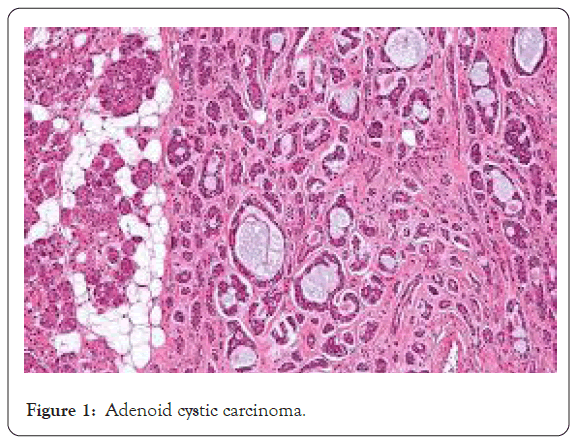Journal of Cancer Research and Immuno-Oncology
Open Access
ISSN: 2684-1266
+44-77-2385-9429
ISSN: 2684-1266
+44-77-2385-9429
Short Communication - (2020)Volume 6, Issue 3
Adenoid cystic carcinoma is a rare form of adenocarcinoma, which is a type of cancer. It can exist in many different body sites and most often occurs in the areas of the head and neck in particular the salivary glands. Adenoid cystic carcinoma has also been reported in the breast, lacrimal gland of the eye, lung, brain, bartholin gland, and trachea. Here symptoms, diagnosis and treatment of Adenoid Cystic Carcinoma (AdCC) are discussed.
Adenoid Cystic Carcinoma (AdCC) is a rare form of adenocarcinoma, describing any cancer that begins in glandular tissues. In general, AdCC is found mainly within the head and neck region. It can occur in other locations in the body, including the breasts or a woman’s uterus occasionally. AdCC most ordinarily occurs within the salivary glands, which contains clusters of cells that secrete saliva scattered throughout the upper aero digestive tract. The upper aero digestive tract includes the organs and tissues of the upper tract, like the lips, mouth, tongue, nose, throat, vocal cords, and a part of the esophagus and windpipe [1]. Adenoid Cystic Carcinoma is shown in Figure 1.

Figure 1: Adenoid cystic carcinoma.
Signs and symptoms of Adenoid Cystic Carcinoma include:
The initial symptoms of AdCC depend upon the situation of the tumour. Early lesions of the salivary glands may appear as painless, usually slow-growing masses underneath the traditional lining of the mouth or skin of the face. Because there are many salivary glands under the mucosal lining of the mouth, throat, and sinuses, lumps in these locations might be from this sort of tumour. Other symptoms may include:
• A lump on the roof of the mouth, under the tongue, or in the bottom of the mouth
• An abnormal area on the lining of the mouth
• Numbness of the upper jaw, palate, face, or tongue
• Difficulty swallowing
• Hoarseness
• Dull pain
• A bump or nodule in front of the ear or underneath the jaw
• Paralysis of a facial nerve [2].
Causes of Adenoid Cystic Carcinoma include:
Activation of the oncogenic transcription factor gene MYB is that the key genomic event of ACC and seen within the overwhelming majority of cases. Most commonly, MYB is activated through gene fusion with the transcription factor encoding NFIB gene as a result of a t (6;9) translocation. Alternatively, MYB is activated by copy number gain or by juxtaposition of enhancer elements within the vicinity of the MYB gene. In a subset of ACCs, the closely related MYBL1 gene is fused to NFIB or to other fusion partners.
MYB drives proliferation of ACC cells and regulates genes involved in cell cycle control, DNA replication and repair, and RNA processing. Thus, the MYB oncogene may be a potential diagnostic and therapeutic target in ACC.
ACC features a relatively quiet genome with few recurrent copy number alterations or point mutations, according to the view that MYB and MYBL1 are the most oncogenic drivers of the disease [3].
Diagnosis of Adenoid Cystic Carcinoma includes:
• Biopsy- A biopsy is the removal of a small amount of tissue for examination under a microscope
• Imaging tests-Imaging techniques, primarily resonance imaging (MRI) or Computerized Tomography (CT) scan, are useful to assist doctors see the dimensions and site of the tumour before surgery. A Positron Emission Tomography (PET) scan can also be wont to determine if the tumour has spread to other parts of the body.
Treatment for Adenoid Cystic Carcinoma might involve:
• Surgery
• External-beam radiation therapy
• Neutron and proton radiation therapy
• Therapies using medication
Systemic therapy is that the use of medication to destroy cancer cells. This type of medication is given through the bloodstream to succeed in cancer cells throughout the body. Systemic therapies are generally prescribed by a medical oncologist.
Common ways to offer systemic therapies include an Intravenous (IV) tube placed into a vein employing a needle or during a pill or capsule that's swallowed (orally).
The types of systemic therapies used for AdCC include:
• Chemotherapy
• Targeted therapy [4].
Citation: Vale S (2020) Adenoid Cystic Carcinoma-Symptoms, Diagnosis and Treatment. J Cancer Res Immunooncol. 6:126.
Received: 09-Nov-2020 Accepted: 23-Nov-2020 Published: 30-Nov-2020 , DOI: 10.35248/2684-1266.20.6.126
Copyright: © 2020 Vale S. This is an open-access article distributed under the terms of the Creative Commons Attribution License, which permits unrestricted use, distribution, and reproduction in any medium, provided the original author and source are credited.